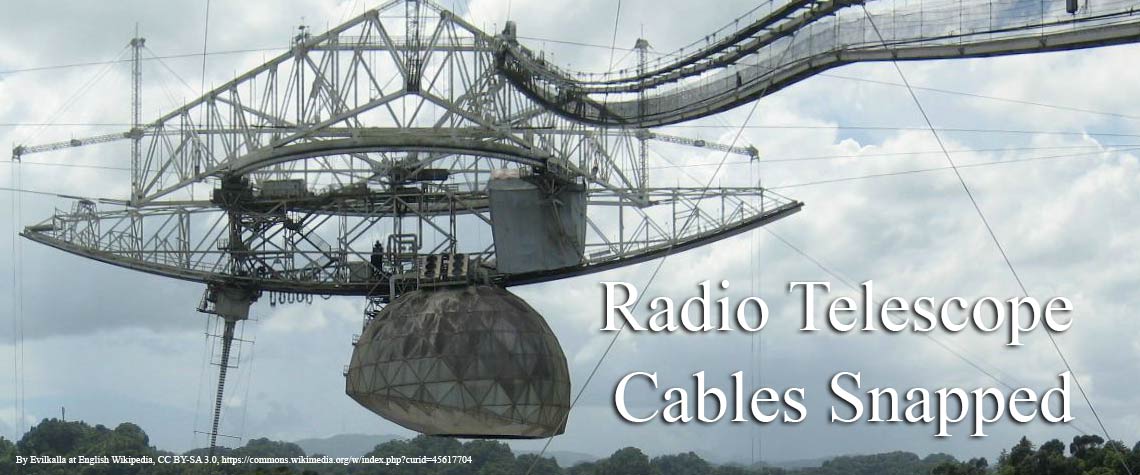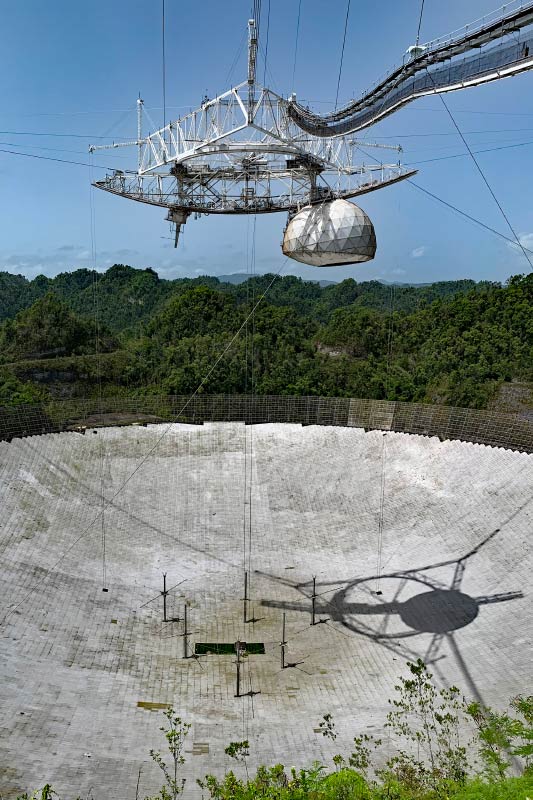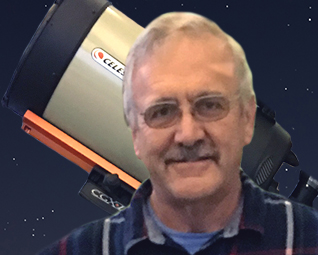Page 3


Arecibo Observatory Telescope Collapses
On December 01, the famed Arecibo Observatory Telescope that was featured in films such as "GoldenEye" and "Contact" and also featured in the video game "Battlefield 4" collapsed at about 08:00 local time. Main cables snapped on the already perilous antenna resulting in it falling and damaging to the dish and surrounding facilities.
Arecibo Observatory, which is in Puerto Rico, was of the world's second-largest single-dish radio telescope. Radio telescopes can work at all times of day and in all kinds of weather, so they are able to work 24 hours a day. The observatory did a lot of astronomy work including searching the heavens for signs of life, finding quasars, looking for asteroids, and searching for planets residing in the habitable zone, an area around a star that is thought to support life. It is best known for being the site of the huge Search for Extra Terrestrial Intelligence (SETI) message directed at the globular cluster M13 in 1974. According to SETI, the broadcast was roughly the same as a 20-trillion-watt omnidirectional broadcast. This inspired the making of the movie "Contact".
The telescope is part of the NAIC (National Astronomy and Ionosphere Center). NSF (The National Science Foundation) has a co-operative agreement with SRI International, the Universities Space Research Association and Puerto Rico's Metropolitan University (UMET) to operate it.
Five decades ago, scientists were looking for a site to put a radio telescope that was close to the equator. This location would allow the telescope to track most of the sky, while also probing the nature of the ionosphere — the layer of the atmosphere in which charged particles produce the northern lights. They found a site in Puerto Rico that had a natural limestone sinkhole that was the natural geometry needed for the dish.
The reflective dish they built there is 1,000 feet (305 meters) in diameter, 161 feet (51 m) deep, and covers an area of about 18 acres (78,000 square meters). The reflector dish is made up of 38,778 perforated aluminum panels. A triangular platform is suspended 450 feet (137 m) above the dish by three concrete towers. The platform holds the azimuth arm, a dome containing two sub-reflectors, and a set of antennae that can be tuned to a narrow band of frequencies from 6 meters (50 MHz) to 3 centimeters (10 GHz) and operates at a power of 1 megawatt.
Lately, Arecibo was frequently used for finding near earth asteroids. The observatory focuses on those that could pose a danger to the planet, making an effort to accurately gauge their sizes and the potential impact it could have.
Arecibo is also the site of the Planetary Habitability Laboratory at the University of Puerto Rico at Arecibo. The group has a habitable planets catalog that tracks the number of planets in other solar systems that could be in the Goldilocks zone, or area that is not too hot or cold for life, of their respective stars.
The observatory has been battered by the elements over the years, most recently by Hurricane Maria in 2017 and an earthquake and aftershocks in January 2014 and December 2019.
After Hurricane Maria, a federal spending bill was passed in February 2018 to provide relief to Puerto Rico allocating $16.3 million to repairing the Arecibo Observatory. The site received hurricane-relief funding in August 2018.
In February 2018, the National Science Foundation — which has provided most of the observatory's funding since the 1970s - announced that it will cut its annual contribution from $8 million to $2 million by FY2023. In April 2018, the University of Central Florida in Orlando took over management and operations of the observatory.
On August 10, one of the 3" auxiliary cables installed in the 1990s that helps support a metal platform in place above the Arecibo Observatory in Puerto Rico, broke away from its socket causing a 100-foot-long gash on the telescope's reflector dish. Operations at the UCF-managed observatory stopped until repairs could be made.
Engineers investigating the break ordered a replacement cable and others to lend support. During their studies, they noticed that one of the 12 main suspension cables—one connected to the same tower as the failed auxiliary cable-had a dozen broken wires around its exterior. Because these 9-centimeter-thick cables are made up of 160 wires, they thought it had enough capacity to shoulder the extra load.
But on November 07, that cable broke. The University of Central Florida (UCF), which leads the consortium managing the facility for NSF, already had three engineering firms on-site assessing the first break. They quickly set about analyzing the safety of the whole structure. NSF sent another firm and the Army Corps of Engineers. Of the five, three said the only way forward was a controlled decommissioning. If one main cable was operating below its design capacity, "now all the cables are suspect," said Ashley Zauderer, NSF's program director for the Arecibo Observatory. If one of three remaining main cables connected to the impaired tower also failed, the engineers concluded, the platform would collapse.
The telescope finally collapsed December 01 at about 07:55 local time (11:55 GMT) on Tuesday.
The NSF said "Initial findings indicate that the top section of all three of the... telescope's support towers broke off. As the 900-ton instrument platform fell, the telescope's support cables also dropped," it said in a statement.
NSF officials insist that the cable failures came as a surprise. After the first, engineering teams spotted a handful of broken wires on the second cable, which was more crucial to holding up the platform, but they did not see it as a major problem because the weight it was carrying was well within its design capacity. "It was not seen as an immediate threat," says Ashley Zauderer, program director for Arecibo at the NSF.
But that main cable, which was installed in the early 1960s, had apparently degraded over time. Over the years, external review committees have highlighted the ongoing need to maintain the ageing cables. Zauderer said that maintenance in recent years had been completed according to schedule.
References:
www.naic.edu
www.ncf.gov
www.Space.com
www.Sciencemag.com
www.nature.com

Panaroma of Arecibo Observatory Telescope
Image Credit for this image and image at the top of the page: Evilkalla at English Wikipedia, CC BY-SA 3.0, https://commons.wikimedia.org/w/index.php?curid=45617704

Arecibo Observatory Telescope in Puerto Rico
Image Credit: By Mariordo (Mario Roberto Durán Ortiz) - Own work, CC BY-SA 4.0, https://commons.wikimedia.org/w/index.php?curid=81590797
About the Author

Warren Bracewell
President
Brazos Valley Astronomy Club